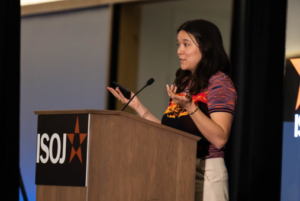OSINT (open-source intelligence) and SOCMINT (social media intelligence) techniques are becoming increasingly accessible to journalists and have proven effective in remote coverage of armed conflicts where it is difficult for reporters to report on the ground. With the different types of collaboration that these techniques make possible and the increasing availability of open source material produced by users and institutions, these techniques offer more and more opportunities for journalism.
These were some of the conclusions of the panel “Using OSINT and SOCMINT for war coverage, investigative reporting and fact-checking” during the first day of the 25 International Symposium on Online Journalism (ISOJ), on April 12, at the University of Texas at Austin.

Speakers on the 25th ISOJ panel “Using OSINT and SOCMINT for war coverage, investigative reporting and fact-checking.” (Patricia Lim/Knight Center)
The panel, moderated by Marc Lavallee, director of technology product and strategy for the journalism program at the Knight Foundation, included Meg Kelly, senior reporter with Visual Forensics of The Washington Post; Haley Willis, visual investigations reporter at The New York Times; Marc Perkins, investigations editor at the BBC World Service; and Eoghan Macguire, lead editor at Bellingcat.
Lavallee started by saying that OSINT and SOCMINT intelligence –which refer to the techniques and tools that allow for the collection and analysis of information from social media platforms and other open sources– have evolved significantly over the past decade from a basic truth of journalism, which is that news happens when journalists are not present, coupled with the fact that more and more people have devices to capture the events around them and share them on the internet.
“So many of the techniques of journalism go to a situation kind of as it is unfolding, or maybe after it happened, using techniques to understand what did happen and to be able to report that out,” he said. “And in this era, when most of the people of the planet have a camera, where satellites are tracking every move globally, there’s so much more of an opportunity to actually take that information.”
Some recent events that made evident the power of OSINT and SOCMINT techniques in journalism, according to the panelists, include the Arab Spring, migrant crises, conflicts in the Middle East and some human rights investigations. And more recently, the ongoing wars in Ukraine and Palestine. The panelists presented journalistic investigations on some of these issues that were possible thanks to open source techniques.
“There were a bunch of videos that were being shared online, that could have been pretty easily debunked, that got me thinking about how we could use the tools at our hands, at our disposal, to tell really compelling stories and hold powerful people accountable for what they were saying,” Kelly said about the time when she worked in The Washington Post’s fact-checking team, before she joined the paper’s Visual Forensics team.
Macguire highlighted the important role that the community plays in the use of open source material for investigations. Bellingcat is a Netherlands-based collective of researchers, investigators and journalists founded in 2014 with the purpose of linking up with publishing partners and harnessing the online open source community to create impact.
As an example of the organization’s engagement with that community, Macguire mentioned a 2022 project that sought to document civilian harm in the Russian invasion of Ukraine. Bellingcat called 15 to 20 people from their Discord community of more than 20,000 members to help them verify some incidents in which civilians had been allegedly harmed by rocket attacks.
The team of volunteers selected, made up mainly of individuals with Ukrainian language skills, geolocation and chronolocation skills, and local contextual knowledge of the place where the events took place, helped the Bellingcat team verifying images and videos gathered from social media. The volunteers' work, Macguire said, was later verified by the Bellingcat team to ensure the organization’s accuracy standards.
“The Bellingcat community manager and staff is in constant contact with the volunteers, giving direction and checking in with them, not just from a practical sense, but also from an ethical sense, making sure they are ok from the safety sense, because the work is hard and it can be gruesome as well, making sure that they are not too impacted by what they are doing,” he said.
Macguire emphasized that these techniques represent a complement of traditional reporting methods and not a replacement of them.
Lavallee said that Bellingcat and other similar organizations such as Storyful and Forensic Architecture, which are not news media in the strict sense of the term, represent partnering opportunities for journalist organizations to venture into OSINT and SOCMINT techniques.
During her presentation, Willis talked about the importance of geolocation and chronolocation in verifying open source material of an armed conflict in the immediate hours after it has started circulating, before it is possible to send a reporter to the scene of the incident.
The journalist presented a New York Times investigation on video footage of the bodies of dead civilians lying on the streets of Bucha, a suburb of Kyiv, Ukraine, in 2022. The analysis rebutted Russia’s claims that the killing of civilians in that town occurred after its soldiers had left.
The Times’ Visual Investigations team was able to determine the location of the incident using Google Maps Street View, and they established the time frame in which the deaths had happened by analyzing satellite imagery.
Willis also highlighted the importance of complementing the OSINT work with traditional reporting. She said that the open source evidence of this investigation served as a guide to drive the fieldwork of the New York Times team that arrived in Bucha days later.
“My team members could go in the field and speak to the neighbors in the houses where these people had been killed, trying to collect cell phone footage that someone from these houses may have filmed, trying to collect security camera footage, if there’s a house across the street that has a security camera,” she said. “The open source reporting kind of led the field reporting and then it went back and forth.”
However, in some cases the fieldwork is just not an option, as it is in the case of the Israel-Hamas war in Gaza. Willis talked about a 2023 investigation in which her team resorted to artificial intelligence to map the use of 2,000-pound bombs by Israel in areas designated safe for civilians.
Willis said that an AI tool helped them detect bomb craters in satellite images. The results were later manually verified by reporters with the help of munition experts. Once they mapped the craters, the team used social media footage and reached out to people in Gaza to try to obtain more information of the impact of the bombs in those locations.
Another newsroom that has combined the OSINT and SOCMINT intelligence with artificial intelligence was the BBC. Perkins spoke about Recognize, a computer vision AI tool that the BBC World Service's investigation unit developed in order to analyze big amounts of open source video footage.
They successfully used this tool in an investigation that showed evidence that tactical mistakes had caused one of the highest concentrations of losses for a single Russian military unit since the beginning of invasion of Ukraine. For this project, the team had to identify soldiers and objects in hundreds of videos scraped from social media and YouTube.
“It [the Recognize tool] would use facial recognition, object detection and it would also use content moderation to filter out different kinds of videos,” Perkins said. “That is very difficult to do manually. If you go back three or four years, you would do this manually, you would have people looking for the same face in videos. This massively speeds up the process.”
The journalist said that, even though these capabilities such as facial recognition have been used for years by militaries or government agencies, nowadays they are within reach for journalists, since costs have become much more manageable.
“I think this is just the very beginning of this process, and I am pretty sure we are now at a stage where some of those core journalistic principles, who (facial recognition), what (object detection), where (geolocation) and when (chronolocation), are pretty close to being automated,” Perkins said.
The recent increase in the use of OSINT and SOCMINT techniques in journalism is due in part to the significant increase in UGC (user-generated content), Perkins said. Previously, Lavallee had mentioned that people are making all kinds of things public intentionally or sometimes unintentionally, and that is a real opportunity for news media to turn it into journalism.
“When I first started in TV, quite a while ago, the cost of a broadcast camera was 100,000 dollars, and a satellite track was half a million. And now it’s all seating in the palm of one person’s hand,” he said. “All of this combined brings an enormous explosion in this UGC content; 500 hours per minute is uploaded to YouTube. And that’s a phenomenal amount of content coming out, and that is a massive gold mine for all of us in this panel, and yet at the same time it requires a huge amount of digging.”

Haley Willis, visual investigations reporter, The New York Times on the Using OSINT and SOCMINT for war coverage, investigative reporting and fact-checking panel at the 25th ISOJ. (Patricia Lim/Knight Center)
But even though the investigations presented by the panelists are complex and touched on global topics, OSINT and SOCMINT techniques can be used in all kinds of coverage, Kelly said.
“We often show these examples that are sort of big and splashy, but it [OSINT work] really can cover all types of different subject matters,” she said.
The panelists agreed that collaboration is a fundamental element when working with open source techniques, whether it is collaboration between media outlets, with experts, or with the community.
For Maguire, collaborating has been one of the most rewarding and more interesting things of his work.
“People who may have a background in chemical weapons can spot the thing that a journalist can’t spot,” he said. “So bringing them in and having them part of the journalistic process I think it’s a positive thing. […] I would encourage other newsrooms to do the same as well.”
Perkins said that there is a hype around the open source techniques on social media, especially among the OSINT community that exists on X. He said that if journalists reach out to them, they often offer very important support.
“It’s quite tricky to manage that, because there’s a difficult balance between what you can hand out, in terms of information that you have gathered, source protection issues and stuff, but if you do put out that and use that hype mind, it’s phenomenal what it gives back, it’s like a multiplier for your journalism”, he said.
Lavallee asked panelists how to deal with "bad actors,” or people trying to influence an investigation one way or the other with their input, when collaborating with external parties. Willis responded that multiple layers of verification and transparency are good tools against that potential harm.
“One of the best parts about this type of work is transparency, I think that’s why it appeals to an audience […] and I also think that it can kind of solve for this potential issue of ‘bad actors’,” she said.
Willis said that when collaborating with parties external to the Times, her team doesn’t just receive that external input and incorporate it into their investigation right away. There is a process for verifying that external input, as there is with the internal work as well.
“We check ourselves within The Times. I’d ask my colleague ‘what do you think about this video that I looked at?,’ and we would independently come to the same conclusion,” she said. “And the same goes for working with external parties as well, because of the way that this work works, they can show their methodology to us and we can recreate it and match those conclusions.”
Even though working with OSINT and SOCMINT techniques requires specific skills and methodologies, they are very approachable, which bring many opportunities for more journalists to be doing more of that in service for their audiences, Lavalle said.
In this regard, Kelly said that while OSINT work can be very resource-intensive and require the use of complex software, sometimes it can also involve tasks that any person can undertake.
“Using things like knowing how to search Facebook, knowing what demographic is going to be on what social platform, or how to best put together a My Map, just like you would if you were going on vacation, can be totally useful tools,” she said.

Marc Perkins, investigations editor, BBC World Service, London, UK on the Using OSINT and SOCMINT for war coverage, investigative reporting and fact-checking panel at the 25th ISOJ. (Patricia Lim/Knight Center)
Maguire said that OSINT and SOCMINT work sometimes feels like “playing the internet detective.” He said that there are many resources available on the internet for journalists interested in learning these techniques.
For example, Bellingcat has a section in which it details its methods and explains how to use particular tools. Also, the organization’s Discord server is a place of constant talking about how members have done OSINT related things.
Perkins added that X is also a good resource for journalists interested in the topic. And he recommended looking for OSINT experts online, such as Benjamin Strick, a former investigator for both BBC and Bellingcat, who has a website and a YouTube channel with useful material about these techniques.
“It’s all learnable. The point about open sources is that it’s complicated, it's not easy, I am really bad at it, that’s why I am glad I am a manager, but actually […] these things are all learnable, it’s not rocket science, you can learn about it yourself, and it’s all out there,” Perkins said.